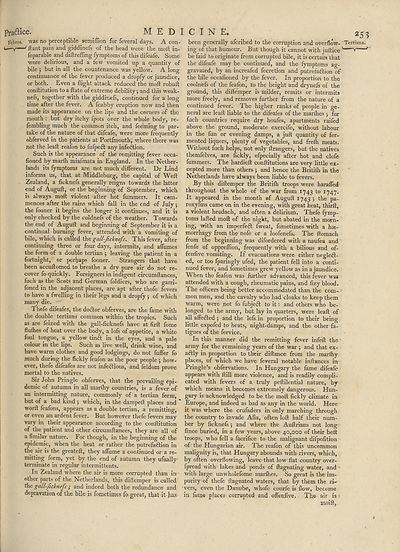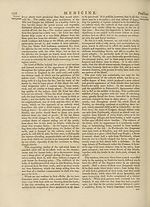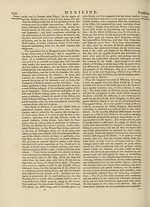Encyclopaedia Britannica, or, a Dictionary of arts, sciences, and miscellaneous literature : enlarged and improved. Illustrated with nearly six hundred engravings > Volume 13, MAT-MIC
(295) Page 253
Download files
Complete book:
Individual page:
Thumbnail gallery: Grid view | List view

praaice. M E D I
Febrcs. was no perceptible semi (lion for feveral days. A con-
i—-v—ftant pain and giddinefs of the head were the moft in-
feparable and diftreffing fymptoms of this difeafe. Some
were delirious, and a few vomited up a quantity of
bile ; but in all the countenance was yellow. A long
continuance of the fever produced a dropfy or jaundice,
or both. Even a flight attack reduced the moft robuft
conftitution to a ftate of extreme debility 5 and this weak-
nefs, together with the giddinefs, continued for a long
time after the fever. A fcabby eruption now and then
made its appearance on the lips and the corners of the
mouth : but dry itchy fpots over the whole body, re-
fembling much the common itch, and feeming to par¬
take of the nature of that difeafe, were more frequently
obferved in the patients at Portfmouth, where there was
not the leaft reafon to fufpedt any infection.
Such is the appearance of the remitting fever occa-
fioned by marfti miafmata in England. In the Nether¬
lands its fymptoms are not much different. Dr Lind
informs us, that at Middleburg, the capital of Weft
Zealand, a ficknefs generally reigns towards the latter
end of Auguft, or the beginning of September, which
is always moft violent after hot fummers. It com¬
mences after the rains which fall in the end of July j
the fooner it begins the longer it continues, and it is
only checked by the coldnefs of the weather. Towards
the end of Auguft and beginning of September it is a
continual burning fever, attended with a vomiting of
bile, which is called the gall-Jicknefs. This fever, after
continuing three or four days, intermits, and affumes
the form of a double tertian •, leaving the patient in a
fortnight, or perhaps fooner. Strangers that have
been accuftomed to breathe a dry pure air do not re¬
cover fo quickly. Foreigners in indigent circumftances,
fuch as the Scots and German foldiers, who are garri-
foned in the adjacent places, are apt after thofe fevers
to have a fwelling in their legs and a dropfy 5 of which
many die. 1
Thefe difeafes, the doctor obferves, are the fame with
the double tertians common within the tropics. Such
as are feized with the gall-ficknefs have at firft fome
flulhes of heat over the body, a lofs of appetite, a white
foul tongue, a yellow tindt in the eyes, and a pale
colour in the lips. Such as live well, drink wine, and
have warm clothes and good lodgings, do not fuffer fo
much during the fickly feafon as the poor people 5 how¬
ever, thefe difeafes are not infectious, and feldom prove
mortal to the natives.
Sir John Pringle obferves, that the prevailing epi¬
demic of autumn in all marftiy countries, is a fever of
an intermitting nature, commonly of a tertian form,
but of a bad kind ; which, in the dampeft places and '
worft feafons, appears as a double tertian, a remitting,
or even an ardent fever. But however thefe fevers may
vary in their appearance according to the conftitution
of the patient and other circumftances, they are all of
a fimilar nature. For though, in the beginning of the
epidemic, when the heat or rather the putrefa&ion in
the air is the greateft, they affume a continued or a re¬
mitting form, yet by the end of autumn they ufually
terminate in regular intermittents.
In Zealand where the air is more corrupted than in
other parts of the Netherlands, this diftemper is called
the gall-Jichnefs; and indeed both the redundance and
depravation of the bile is fometimes fo great, that it has
CINE. 253
been generally afcribed to the corruption and overflow- Tertiana.
ing of that humour. But though it cannot with juftice —v—
be faid to originate from corrupted bile, it is certain that
the difeafe may be continued, and the fymptoms ag¬
gravated, by an increafed fecretion and putrefa&ion of
the bile occaiioned by the fever. In proportion to the
coolnefs of the feafon, to the height and drynefs of the
ground, this diftemper is milder, remits or intermits
more freely, and removes further from the nature of a
continued fever. The higher ranks of people in ge¬
neral are leaft liable to the difeafes of the marihes ; for
fuch countries require dry houfes, apartments raifed
above the ground, moderate exercife, without labour
in the fun or evening damps, a juft quantity of fer¬
mented liquors, plenty of vegetables, and frefh meats.
Without fuch helps, not only ftrangers, but the natives
themfelves, are iickly, efpecially after hot and clofe
fummers. The hardieft conftitutions are very little ex¬
cepted more than others j and hence the Britifti in the
Netherlands have always been liable to fevers.
By this diftemper the Britifti troops were haraffed
throughout the whole of the war from 1743 to 1747.
It appeared in the month of Auguft 1743 > Pa~
roxyfms came on in the evening, with great heat, thirft,
a violent headach, and often a delirium. Thefe fymp¬
toms lafted moft of the night, but abated in the morn-
ing, with an imperfedt fweat, fometimes with a hae-
morrhagy from the nofe or a loofenefs. The ftomach
from the beginning was difordered with a naufea and
fenfe of oppreflion, frequently with a bilious and of-
fenfive vomiting. If evacuations were either negledt-
ed, or too fparingly ufed, the patient fell into a conti¬
nued fever, and fometimes grew yellow as in a jaundice.
When the feafon was further advanced, this fever was
attended with a cough, rheumatic pains, and fizy blood.
The officers being better accommodated than the com¬
mon men, and the cavalry who had cloaks to keep them
warm, were not fo fubjedl to it: and others who be¬
longed to the army, but lay in quarters, were leaft of
all affedted j and the lefs in proportion to their being
little expofed to heats, night-damps, and the other fa¬
tigues of the fervice.
In this manner did the remitting fever infeft the
army for the remaining years of the war j and that ex-
adtly in proportion to their diftance from the marftiy
places, of which we have feveral notable inftances in
Pringle’s obfervations. In Hungary the fame difeafe
appears with ftill more violence, and is readily compli¬
cated with fevers of a truly peftilential nature, by
which means it becomes extremely dangerous. Hun¬
gary is acknowledged to be the moft fickly climate in
Europe, and indeed as bad as any in the world. Here
it was where the crufaders in only marching through
the country to invade Afia, often loft half their num¬
ber by ficknefs 5 and where the Auftrians not long
fince buried, in a few years, above 40,000 of their belt
troops, who fell a facrifice to the malignant difpofition
of the Hungarian air. The reafon of this uncommon
malignity is, that Hungary abounds with rivers, which,
by often overflowing, leave that low flat country over-
fpread with lakes and ponds of ftagnating water, and
with large unwholefome marfties. So great is the im¬
purity of thefe ftagnated waters, that by them the ri-
'vers, even the Danube, whofe courfe is flow, become
in feme places corrupted and offenfive. The air is •
moift.
Febrcs. was no perceptible semi (lion for feveral days. A con-
i—-v—ftant pain and giddinefs of the head were the moft in-
feparable and diftreffing fymptoms of this difeafe. Some
were delirious, and a few vomited up a quantity of
bile ; but in all the countenance was yellow. A long
continuance of the fever produced a dropfy or jaundice,
or both. Even a flight attack reduced the moft robuft
conftitution to a ftate of extreme debility 5 and this weak-
nefs, together with the giddinefs, continued for a long
time after the fever. A fcabby eruption now and then
made its appearance on the lips and the corners of the
mouth : but dry itchy fpots over the whole body, re-
fembling much the common itch, and feeming to par¬
take of the nature of that difeafe, were more frequently
obferved in the patients at Portfmouth, where there was
not the leaft reafon to fufpedt any infection.
Such is the appearance of the remitting fever occa-
fioned by marfti miafmata in England. In the Nether¬
lands its fymptoms are not much different. Dr Lind
informs us, that at Middleburg, the capital of Weft
Zealand, a ficknefs generally reigns towards the latter
end of Auguft, or the beginning of September, which
is always moft violent after hot fummers. It com¬
mences after the rains which fall in the end of July j
the fooner it begins the longer it continues, and it is
only checked by the coldnefs of the weather. Towards
the end of Auguft and beginning of September it is a
continual burning fever, attended with a vomiting of
bile, which is called the gall-Jicknefs. This fever, after
continuing three or four days, intermits, and affumes
the form of a double tertian •, leaving the patient in a
fortnight, or perhaps fooner. Strangers that have
been accuftomed to breathe a dry pure air do not re¬
cover fo quickly. Foreigners in indigent circumftances,
fuch as the Scots and German foldiers, who are garri-
foned in the adjacent places, are apt after thofe fevers
to have a fwelling in their legs and a dropfy 5 of which
many die. 1
Thefe difeafes, the doctor obferves, are the fame with
the double tertians common within the tropics. Such
as are feized with the gall-ficknefs have at firft fome
flulhes of heat over the body, a lofs of appetite, a white
foul tongue, a yellow tindt in the eyes, and a pale
colour in the lips. Such as live well, drink wine, and
have warm clothes and good lodgings, do not fuffer fo
much during the fickly feafon as the poor people 5 how¬
ever, thefe difeafes are not infectious, and feldom prove
mortal to the natives.
Sir John Pringle obferves, that the prevailing epi¬
demic of autumn in all marftiy countries, is a fever of
an intermitting nature, commonly of a tertian form,
but of a bad kind ; which, in the dampeft places and '
worft feafons, appears as a double tertian, a remitting,
or even an ardent fever. But however thefe fevers may
vary in their appearance according to the conftitution
of the patient and other circumftances, they are all of
a fimilar nature. For though, in the beginning of the
epidemic, when the heat or rather the putrefa&ion in
the air is the greateft, they affume a continued or a re¬
mitting form, yet by the end of autumn they ufually
terminate in regular intermittents.
In Zealand where the air is more corrupted than in
other parts of the Netherlands, this diftemper is called
the gall-Jichnefs; and indeed both the redundance and
depravation of the bile is fometimes fo great, that it has
CINE. 253
been generally afcribed to the corruption and overflow- Tertiana.
ing of that humour. But though it cannot with juftice —v—
be faid to originate from corrupted bile, it is certain that
the difeafe may be continued, and the fymptoms ag¬
gravated, by an increafed fecretion and putrefa&ion of
the bile occaiioned by the fever. In proportion to the
coolnefs of the feafon, to the height and drynefs of the
ground, this diftemper is milder, remits or intermits
more freely, and removes further from the nature of a
continued fever. The higher ranks of people in ge¬
neral are leaft liable to the difeafes of the marihes ; for
fuch countries require dry houfes, apartments raifed
above the ground, moderate exercife, without labour
in the fun or evening damps, a juft quantity of fer¬
mented liquors, plenty of vegetables, and frefh meats.
Without fuch helps, not only ftrangers, but the natives
themfelves, are iickly, efpecially after hot and clofe
fummers. The hardieft conftitutions are very little ex¬
cepted more than others j and hence the Britifti in the
Netherlands have always been liable to fevers.
By this diftemper the Britifti troops were haraffed
throughout the whole of the war from 1743 to 1747.
It appeared in the month of Auguft 1743 > Pa~
roxyfms came on in the evening, with great heat, thirft,
a violent headach, and often a delirium. Thefe fymp¬
toms lafted moft of the night, but abated in the morn-
ing, with an imperfedt fweat, fometimes with a hae-
morrhagy from the nofe or a loofenefs. The ftomach
from the beginning was difordered with a naufea and
fenfe of oppreflion, frequently with a bilious and of-
fenfive vomiting. If evacuations were either negledt-
ed, or too fparingly ufed, the patient fell into a conti¬
nued fever, and fometimes grew yellow as in a jaundice.
When the feafon was further advanced, this fever was
attended with a cough, rheumatic pains, and fizy blood.
The officers being better accommodated than the com¬
mon men, and the cavalry who had cloaks to keep them
warm, were not fo fubjedl to it: and others who be¬
longed to the army, but lay in quarters, were leaft of
all affedted j and the lefs in proportion to their being
little expofed to heats, night-damps, and the other fa¬
tigues of the fervice.
In this manner did the remitting fever infeft the
army for the remaining years of the war j and that ex-
adtly in proportion to their diftance from the marftiy
places, of which we have feveral notable inftances in
Pringle’s obfervations. In Hungary the fame difeafe
appears with ftill more violence, and is readily compli¬
cated with fevers of a truly peftilential nature, by
which means it becomes extremely dangerous. Hun¬
gary is acknowledged to be the moft fickly climate in
Europe, and indeed as bad as any in the world. Here
it was where the crufaders in only marching through
the country to invade Afia, often loft half their num¬
ber by ficknefs 5 and where the Auftrians not long
fince buried, in a few years, above 40,000 of their belt
troops, who fell a facrifice to the malignant difpofition
of the Hungarian air. The reafon of this uncommon
malignity is, that Hungary abounds with rivers, which,
by often overflowing, leave that low flat country over-
fpread with lakes and ponds of ftagnating water, and
with large unwholefome marfties. So great is the im¬
purity of thefe ftagnated waters, that by them the ri-
'vers, even the Danube, whofe courfe is flow, become
in feme places corrupted and offenfive. The air is •
moift.
Set display mode to:
![]() Universal Viewer |
Universal Viewer | ![]() Mirador |
Large image | Transcription
Mirador |
Large image | Transcription
Images and transcriptions on this page, including medium image downloads, may be used under the Creative Commons Attribution 4.0 International Licence unless otherwise stated. ![]()
| Permanent URL | https://digital.nls.uk/192664997 |
|---|
| Attribution and copyright: |
|
|---|
| Description | Ten editions of 'Encyclopaedia Britannica', issued from 1768-1903, in 231 volumes. Originally issued in 100 weekly parts (3 volumes) between 1768 and 1771 by publishers: Colin Macfarquhar and Andrew Bell (Edinburgh); editor: William Smellie: engraver: Andrew Bell. Expanded editions in the 19th century featured more volumes and contributions from leading experts in their fields. Managed and published in Edinburgh up to the 9th edition (25 volumes, from 1875-1889); the 10th edition (1902-1903) re-issued the 9th edition, with 11 supplementary volumes. |
|---|---|
| Additional NLS resources: |
|

